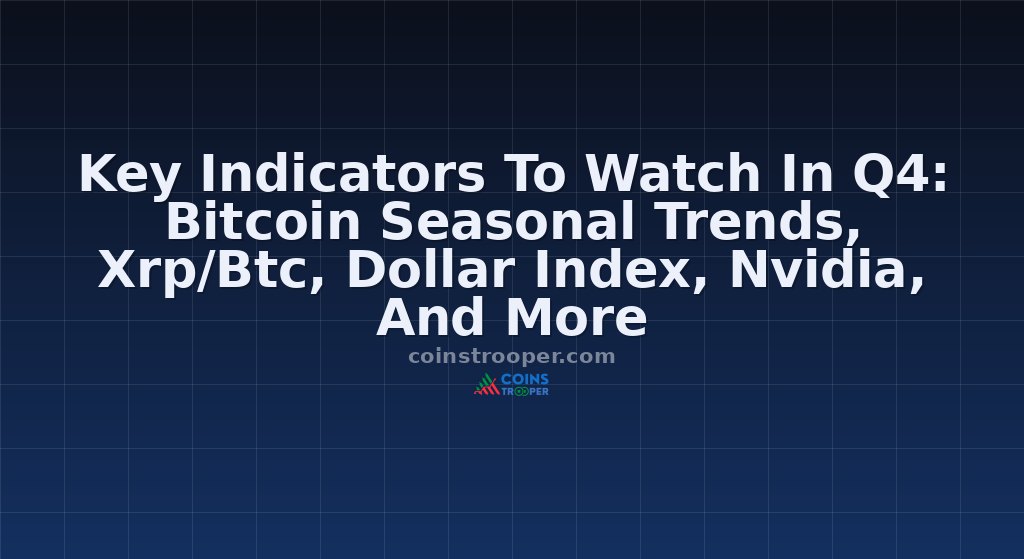Key Indicators To Watch In Q4: Bitcoin Seasonal Trends, Xrp/Btc, Dollar Index, Nvidia, And More

- This is an analysis post by CoinDesk analyst and Chartered Market Technician Omkar Godbole.
- As we approach the final quarter of 2025, the following key charts provide valuable insights to help crypto traders navigate the evolving market landscape.
- Seasonal trends suggest a bullish Q4 outlook for both bitcoin (BTC) and ether (ETH), the top two cryptocurrencies by market capitalization.
- November stands out as the most bullish month, with an average gain of 46%, followed by October, which typically sees a 21% increase.
What Happened
The leveraged anti-Strategy ETF (SMST), which seeks to deliver daily investment results that are -200%, or minus 2x, the daily percentage change in bitcoin-holder Strategy's (MSTR) share price, is flashing bullish signals.
Market Context
This is an analysis post by CoinDesk analyst and Chartered Market Technician Omkar Godbole.
As we approach the final quarter of 2025, the following key charts provide valuable insights to help crypto traders navigate the evolving market landscape.
Seasonal trends suggest a bullish Q4 outlook for both bitcoin (BTC) and ether (ETH), the top two cryptocurrencies by market capitalization.
Bitcoin's price has dropped by 5% this week, consistent with the bearish technical signals and looks set to extend losses to late August lows near $107,300. If bulls fail to defend that, the focus will shift to the 200-day simple moving average at $104,200.
The ongoing price decline, combined with bitcoin's historical pattern of peaking approximately 16 to 18 months after a halving event, may scare bulls.
However, such concerns may be premature as long as prices remain above the 50-week simple moving average (SMA). This moving average has consistently acted as a support level, marking the end of corrective price pullbacks during the current bull run that began in early 2023.
Traders, therefore, should closely watch the 50-week SMA, which is currently positioned around $98,900, as a key level for broader market direction.
XRP, often called the "U.S. government coin" by firms like Arca, has surged 32% this year. However, despite this strong rally, the payments-focused cryptocurrency remains confined within a prolonged sideways trading range against Bitcoin (XRP/BTC), showing limited relative strength.
The XRP/BTC pair has been confined within a narrow trading range since early 2021, resulting in over four years of low-volatility compression.
Recent price action near the upper boundary of this channel suggests that bulls are gradually gaining control. A breakout from such a prolonged consolidation could trigger a powerful rally in XRP relative to BTC, as the accumulated energy from this squeeze is released.
The ETF’s price climbed to a five-month high of $35.65, forming what appears to be an inverse head-and-shoulders pattern, characterized by a prominent trough (the head) flanked by two smaller, roughly equal troughs (the shoulders).
Why It Matters
This pattern often signals a potential bullish reversal, suggesting the ETF may be gearing up for a significant upward move.
In other words, it's flashing a bearish signal for both BTC and Strategy, which is the largest publicly listed BTC holder with a coin stash of 639,835 BTC.
Last week, I discussed the dollar's post-Fed rate cut resilience as a potential headwind for risk assets, including cryptocurrencies.
Details
Bullish seasonality
Since 2013, Bitcoin (BTC) has delivered an average return of 85% in the final quarter, according to data from Coinglass, making Q4 historically the strongest period for bulls.
November stands out as the most bullish month, with an average gain of 46%, followed by October, which typically sees a 21% increase.
Ether (ETH) also tends to perform well in the last three months of the year, although its strongest historical returns have been in the first quarter since inception.
BTC's 50-week SMA support
XRP/BTC compression
Now, let’s turn to charts that call for caution.
Breakout in Defiance Daily Target 2x Short MSTR ETF (SMST)
Dollar Index's double bottom

